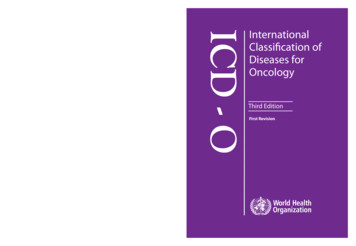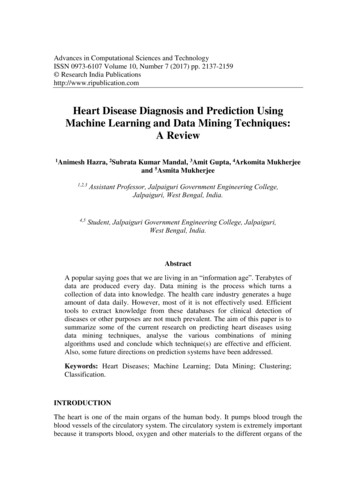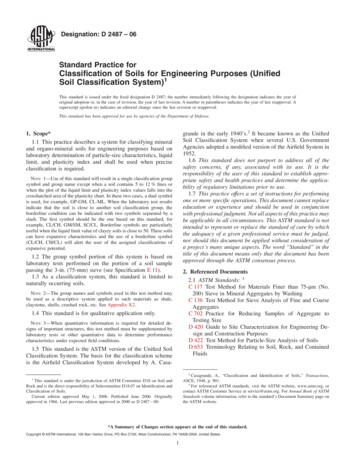
Transcription
ICD - OInternational Classification of Diseases for OncologyInternationalClassification ofDiseases forOncologyThird EditionFirst RevisionISBN 978 92 4 154849 6ICD-O Cover.indd 111/21/13 8:50 AM
ICD - OInternationalClassification ofDiseases forOncologyThird EditionFirst RevisionEditorsApril FritzConstance PercyAndrew JackKanagaratnam ShanmugaratnamLeslie SobinD Max ParkinSharon Whelan
WHO Library Cataloguing-in-Publication DataInternational classification of diseases for oncology (ICD-O) – 3rd edition, 1st revision.1.Neoplams - classification. I.World Health Organization. II.ICD-O.ISBN 978 92 4 154849 6ISBN 978 92 4 069212 1 (PDF)(NLM classification: QZ 15) World Health Organization 2013All rights reserved. Publications of the World Health Organization are available on the WHO web site (www.who.int) or can bepurchased from WHO Press, World Health Organization, 20 Avenue Appia, 1211 Geneva 27, Switzerland (tel.: 41 22 791 3264;fax: 41 22 791 4857; e-mail: bookorders@who.int).Requests for permission to reproduce or translate WHO publications –whether for sale or for non-commercial distribution–should be addressed to WHO Press through the WHO web site (www.who.int/about/licensing/copyright form/en/index.html).The designations employed and the presentation of the material in this publication do not imply the expression of any opinionwhatsoever on the part of the World Health Organization concerning the legal status of any country, territory, city or area or ofits authorities, or concerning the delimitation of its frontiers or boundaries. Dotted lines on maps represent approximate borderlines for which there may not yet be full agreement.The mention of specific companies or of certain manufacturers’ products does not imply that they are endorsed orrecommended by the World Health Organization in preference to others of a similar nature that are not mentioned. Errors andomissions excepted, the names of proprietary products are distinguished by initial capital letters.All reasonable precautions have been taken by the World Health Organization to verify the information contained in thispublication. However, the published material is being distributed without warranty of any kind, either expressed or implied.The responsibility for the interpretation and use of the material lies with the reader. In no event shall the World HealthOrganization be liable for damages arising from its use.Printed in Malta
ContentsDedicationAcknowledgementsvvii1. Introduction1.1 Historical background112. Differences between ICD-O and ICD-102.1 ICD-10 categories not used in ICD-O, third edition2.2 Special codes in ICD-O for topography of lymph nodes (C77) andhematopoietic and reticuloendothelial systems (C42)2.3 Hydatidiform mole and neurofibromatosis (Von Recklinghausen disease except bone)2.4 HIV disease and AIDS2.5 Functions of neoplasms4566663. Structure and format of ICD-O, third edition3.1 Abbreviations3.2 American and British spelling3.3 Topography – numerical list3.4 Morphology – numerical list3.5 Format of ICD-O terms in numerical list3.6 Alphabetic index3.7 Format and use of alphabetic index3.8 Tumor-like lesions and conditions3.9 Lymphoma and leukemia listings3.10 Meaning of “NOS” (not otherwise specified) and how it is used3.11 Meaning of [OBS] (obsolete) and how it is used3.12 The hematologic malignancies3.13 Using the lymphoma and leukemia sections of ICD-O7777788999101010144. Coding guidelines for topography and morphology4.1 Summary of principal rules for using ICD-O, third edition4.2 Topography4.3 Morphology4.4 Multiple primary neoplasms4.5 Basis of diagnosis4.6 WHO grading system for central nervous system tumors and the ICD-O grade code14141619242727References29iii
Numerical listsTopography5th digit behavior code for neoplasms6th digit code for histological grading and differentiation6th digit code for immunophenotype designation for lymphomas and leukemiasMorphology313352525253Alphabetic index95Appendixes1: New codes in ICD-O, third edition2: New morphology terms and synonyms in ICD-O, third edition3: Terms that changed morphology code in ICD-O, third edition4: Terms that changed from tumor-like lesions to neoplasms in ICD-O, third edition5: Terms in ICD-O, second edition, which were deleted for ICD-O, third edition6: ICD-O, second edition, terms that changed behaviour code for ICD-O, third edition7: New codes, preferred terms, related terms, and synonyms in this ICD-O,third edition, first revisioniv217217222227230230231233
DedicationCalum Muir1930–1995This third edition of the International Classification of Diseases for Oncology (ICD-O) isdedicated to the memory of Dr Calum Muir.Calum Muir was an editor of the second edition of ICD-O. As a pathologist, he didmuch to assemble the new morphologic terms and the latest classifications for lymphomas,leukemias and brain tumors. His contacts with cancer registries throughout the world helpedto implement ICD-O worldwide.After his retirement from the International Agency for Research on Cancer, initiallyas Chief of the Unit of Epidemiology and later as its Deputy Director, Calum Muir becamethe Director of Cancer Registration for Scotland. He was instrumental in founding theInternational Association of Cancer Registries (IARC) in 1966, serving as Deputy Secretaryfrom 1972 to 1990 and as President from 1992 until his death.Calum Muir’s spirit and devotion to accurate and complete classification of neoplasmslives on in this edition.iv
AcknowledgementsWe are grateful to the following individuals and their institutions for their contributions to thisedition of ICD-O.Dr Timothy Coté, National Cancer Institute, Bethesda, MD, USAMme Catherine Exbrayat, Registre des Cancers de l’Isère, Isère, FranceProfessor Ekkehard Grundmann, Gerhard Domagk Institut für Pathologie, MünsterUniversität, Münster, GermanyProfessor Paul Hermanek, Chirurgische Klinik mit Poliklinik der Universität ErlangenNürnberg, Erlangen, GermanyDr Elaine Jaffe, National Cancer Institute, Bethesda, MD, USADr Paul Kleihues, International Agency for Research on Cancer, Lyon, FranceDr Franco Rilke, Società Italiana di Cancerologia, Milan, ItalyDr James Vardiman, University of Chicago, Chicago, IL, USAMrs Annette Hurlbut, Fulton, NY, USAWe greatly appreciate the input of the expert groups that provided valuable backgroundmaterial for the development of this third edition and gave the editors the benefit of their adviceon the field-trial edition:European Network of Cancer Registries (ENCR) Working Group on the coding ofhaematological malignancies and lymphomasDr Renée Otter, Comprehensive Cancer Centre North, Groningen, The NetherlandsDr Aurora Astudillo, Hospital General de Asturias, Oviedo, SpainProfessor Paule Marie Carli, Registre des Hémopathies Malignes en Côte d’Or, Dijon,FranceDr Andrew Jack, Leukaemia Research Fund, University of Leeds, Leeds, EnglandDr Han Van Krieken, The Academic Hospital, Leiden, The NetherlandsInternational Society of Pediatric Oncology (SIOP) Working GroupProfessor Jillian M. Birch, CRC Paediatric and Familial Cancer Research Group,Manchester, EnglandDr James Ironside, National Creutzfeldt-Jakob Disease Surveillance Unit, WesternGeneral Hospital, Edinburgh, ScotlandDr Anna M. Kelsey, Royal Manchester Children’s Hospital, Manchester, EnglandProfessor Dietmar Schmidt, Institut für Pathologie, Mannheim, GermanyWe would like to thank the cancer registries and the pathologists and data collectorsassociated with these registries who put an immense amount of careful work into the fieldtesting of ICD-O, third edition.Australia, New South WalesAustralia, SouthCanada, ManitobaAustralia, VictoriaCanada, OntarioBelarusCanada, Ontario, Princess MargaretBelgiumHospitalBrazil, CampinasCanada, Nova ScotiaBrazil, Porto AlegreChina, BeijingCanada, British ColumbiaChina, Qidongvii
International classification of diseases, third edition, first revisionCubaCzech RepublicEcuador, QuitoEgypt, AlexandriaFrance, Haut-RhinFrance, Hémopathies Malignes enCôte d’OrFrance, HéraultFrance, TarnGermany, Baden-WürttembergGermany, Federal States of BerlinGermany, National ChildhoodGuinea, ConakryIndonesiaItaly, FerraraItaly, MacerataItaly, RagusaItaly, RomagnaJapan, HiroshimaJapan, NagasakiJapan, OsakaLithuaniaMaltaNetherlands, AmsterdamNew ZealandPakistan, KarachiPeru, LimaPeru, TrujilloPhilippines, ManilaPhilippines, RizalPoland, KielceSaudi ArabiaSingaporeSloveniaSouth AfricaSpain, AsturiasSpain, GranadaSpain, MallorcaSpain, MurciaSweden, GothenburgThailand, BangkokThailand, Chiang MaiTrinidad and TobagoUganda, KampalaUnited Kingdom, East AngliaUnited Kingdom, Northern and YorkshireUnited Kingdom, Oxford, NationalChildhoodUSA, Florida, Flagler HospitalUSA, Georgia, Medical Center of CentralGeorgiaUSA, Missouri, Liberty HospitalUSA, Ohio, Upper Valley Medical CenterUSA (SEER), AtlantaUSA (SEER), ConnecticutUSA (SEER), DetroitUSA (SEER), HawaiiUSA (SEER), IowaUSA (SEER), Los AngelesUSA (SEER), New MexicoUSA (SEER), Northern CaliforniaUSA (SEER), Seattle/Puget SoundUSA (SEER), UtahUSA, Texas, College Station MedicalCenterViet Nam, Ho Chi MinhWe also gratefully acknowledge the many individuals, institutions, and registries thattook the time to complete the International Association of Cancer Registries’ questionnaireand the many registries that offered to participate in the Field Trial when this edition was indevelopment.viii
1. IntroductionThe International Classification of Diseases forOncology (ICD-O) (1) has been used for nearly35 years, principally in tumor or cancer registries, for coding the site (topography) and thehistology (morphology) of the neoplasm, usuallyobtained from a pathology report. By agreementwith the College of American Pathologists, themorphology section of ICD-O is incorporatedinto the Systematized Nomenclature of Medicine(SNOMED) (2, 3) classification as the neoplasmsection of the morphology field.The International Classification of Diseases forOncology, Second Edition (4), edited by ConstancePercy, Valerie Van Holten and Calum Muir, waspublished in 1990. The topography section of thisthird edition remains the same as in the secondedition, which is based on the neoplasm section ofICD-10 (5). However, the morphology section hasbeen revised. New classifications, especially forlymphomas and leukemias have been introducedand new codes assigned to accommodate them.Some years ago the REAL (Revised European–American Lymphoma) Classification (6) for NonHodgkin Lymphoma was introduced and registrarsneeded ICD-O codes to record these tumors. Also,the terms of the FAB (French–American–British)system (7) for leukemias were added. When theICD-O working group convened in 1998, therewas thought of revising only these two sections,but it was finally decided to review the entire book.The third edition of the ICD-O morphology section was field-tested during 1999. We are gratefulto registries around the world for their commentson the content of this edition.Although one of the prime commitments ofthe editors was to change as few terms as possible,to add new terms at empty spaces, and not to reusepreviously assigned codes, this has not always beenpossible. In order to keep groups of similar entities together, the codes for some terms had to bechanged. Furthermore, the sequence or grouping of terms may not always be as logical as possible because of the limitations of available codenumbers.In developing the previous editions and thepresent edition of ICD-O, a particular effortwas made to use the nomenclature appearing inthe World Health Organization’s InternationalHistological Classification of Tumours series(WHO “Blue Books”) (8). This series covers all theprincipal sites of cancer and includes the morphology codes of ICD-O for each neoplasm.New morphologic terms added since thepublication of the second edition are listed at theback of this book. Refractory anemia and othermyelodysplastic syndromes are now considered tobe malignant; their behavior codes have thereforebeen changed from /1 (uncertain whether benignor malignant) to /3. Ovarian cystadenomas of borderline malignancy which were coded as malignantin ICD-O second edition revert to /1 in the thirdedition. For the sake of consistency in longitudinal databases, it is recommended that all of theseovarian cystadenomas of borderline malignancybe recoded to /1 or removed from the database.Since the publication of ICD-O third editionin 2000, updates to the WHO Blue Book serieshave continued. During the development of thefourth edition of the Blue Book volumes, chapterauthors worked with the International Agency forResearch on Cancer/International Classification ofDiseases for Oncology (IARC/ICD-O) Committeefor ICD-O-3 to review recently identified neoplasm entities and assign morphology codes. Thisupdated version of ICD-O-3 includes the newterms, codes, synonyms, related terms, morphology and behavior code changes from the WHOBlue Books published between 2007 and 2010 ontumors of hematopoietic and lymphoid tissues (9),central nervous system (10), and digestive system(11). Appendix 0 in this manual is a summary ofterms and codes added or revised since the original publication of ICD-O-3.1.1 Historical backgroundSince 1893 there has been an international classification for coding mortality. When the UnitedNations was formed after the Second World Warand the World Health Organization (WHO)was established, they took charge of publishingthese classifications. Table 1 displays the historical lineage of ICD-O. The Sixth Revision of theInternational Statistical Classification of Diseases,Injuries, and Causes of Death (ICD) (12) was published in 1948 and soon afterwards it began to beused to code and tabulate not only mortality databut also morbidity data.In the early years of nomenclature and codingof neoplasms (1950s and 1960s), the principalsystem for classifying diseases was the ICD series1
International classification of diseases, third edition, first revisionTable 1.Coding of neoplasms 1946-2000: historical lineage of ICD-O (1–5, AMACAP(15)USAICDA-81967(19)SNDO4th ed. 19515th ed. 1961(11)SNOP1965Sections 8, 9Neoplasms(13)WHOICDA-81967BothTopography andMorphology(14)Chapter II er II gyNeoplasms1977(2)CAP(17)CPHAICD-101992(5)Chapter II NeoplasmsWHOICD-OSecond Ed.1990WHOICD-OThird Ed.2000WHONote: Numbers in boxes correspond to reference list at the end of this section.2(1)(4)SNOMED III(International)Neoplasms1993(3)CAP(20)SNOMED RT2000 CAPSNOMET-CTIHTSDOCAP
1. Introductionpublished by WHO. Eventually ICD was usedto code and tabulate the diagnoses on medicalrecords for storage and retrieval, and Chapter II ofICD was always designated for neoplasms.Since the publication of the Sixth Revision ofICD in 1948, the classification of neoplasms hasbeen based primarily on topographic site andbehavior (whether the neoplasm is malignant,benign, or not specified). Except for lymphaticand hematopoietic neoplasms, choriocarcinoma,melanoma, and certain benign neoplasms, therehad been no coded nomenclature for other histologic types.The first code manual for the morphology ofneoplasms was published by the American CancerSociety (ACS) in 1951 as the Manual of tumornomenclature and coding (MOTNAC) (13) andconsisted of a two-digit code for morphology witha third digit denoting the behavior of the neoplasm. This code was the basis of a statistical codeproposed by WHO in 1956 for tumor morphology.In the 1960s the College of AmericanPathologists (CAP) decided to develop a classification for all pathologic entities. With the aid of theACS, the CAP published the Systematized nomenclature of pathology (SNOP) (14). SNOP provideda morphology code including two sections (8,12) on neoplasms and a completely new, highlydetailed topography code to cover the whole body.The agreement that was reached stipulated thatthe ACS could use the SNOP neoplasm morphology sections 8 and 9 and publish these with theirown topography codes. Since cancer registrieshad always used the malignant neoplasm sectionof ICD for topography, ACS based topography onthe malignant neoplasm section of ICD-8. A newedition of MOTNAC appeared in 1968 (15), andwas used extensively by cancer registrars.In 1968, the International Agency for Researchon Cancer (IARC) was asked by WHO to makerecommendations about the content and structureof the neoplasm chapter for ICD-9 in consultationwith the cancer and ICD units of WHO and various national bodies. Physicians expressed a desirefor a cancer supplement that would also includemorphology. Many consultants worldwide madesuggestions for the neoplasm section of ICD-9and emphasized the need for the coding of morphology or histology of tumors. They suggestedusing the 1968 edition of MOTNAC as a basis forthe morphology (histology) section: the morphology section of MOTNAC had been based on theneoplasm section of the SNOP published in 1965by the CAP. MOTNAC was widely accepted andtranslated into a number of languages.Working parties for ICD-9 also recommendeda requirement that the morphology of a tumor berecorded and coded. For many years, oncologistshad realized that knowledge solely of the site ortopography of a tumor was not sufficient for planning treatment or conducting research. For example, incidence and survival rates differ accordingto the histologic type of the tumor.The working parties further recommendedthat a special adaptation of ICD, designated theInternational Classification of Diseases for Oncology(1), be created as the successor to MOTNAC foruse by specialists in oncology requiring greaterdetail of histologic classification. This recommendation was endorsed by a Study Group on theClassification of Diseases convened by WHO in1971.Among the options examined was the highlysuccessful 1968 edition of MOTNAC. In 1976,WHO published the first edition of the InternationalClassification of Diseases for Oncology, which hada topography section based on the malignant neoplasm rubrics of ICD-9 and a morphology sectionthat was a one-digit expansion of the MOTNACmorphology. The CAP adopted the morphologyof ICD-O for their revised edition of SNOP whichwas called Systematized Nomenclature of Medicine(SNOMED) (2). The topography in SNOMED wasagain entirely different from that of ICD-O. Someof the SNOMED morphology terms for nonneoplastic tumor-like lesions and premalignantconditions are listed in ICD-O to help the userdifferentiate these terms from true neoplasms.The SNOMED codes are no longer given becauseof continual change to the codes, now principally published on the Internet. An ICD-O usersimply needs to recognize that a term referencedto SNOMED is not a neoplasm.The second edition of the InternationalClassification of Diseases for Oncology (4) wasdeveloped by a WHO/IARC working party andedited by Constance Percy, Valerie Van Holten,and Calum Muir. It was published by WHO in1990 for use in cancer registries and in pathologyand other departments specializing in cancer. Itis a dual classification and coding system for bothtopography and morphology. The topography codeuses the same three- and four-character categoriesas ICD-10 for malignant neoplasms (C00–C80),allowing greater specificity for the site of nonmalignant neoplasms than is possible in ICD-10.3
International classification of diseases, third edition, first revisionThe second edition of ICD-O has been used extensively throughout the world and has been translated into many languages, including Chinese,Czech, Dutch, Finnish, French, German, Greek,Italian, Japanese, Korean, Portuguese, Romanian,Russian, Slovak, Spanish and Turkish.This third edition of ICD-O has been developedby a working party convened by IARC/WHO. Themorphology code for neoplasms has been revised,especially for lymphomas and leukemias. Thecodes incorporate the WHO classification (24, 25),which superseded the REAL (Revised European–American Lymphoma) classification for lymphomas (6) and the FAB (French–American–British)classification for leukemias (7). The third editionalso recognizes the WHO classification of myeloidleukemias, which includes distinct combinationsof morphology and cytogenetic abnormalities, forexample 9875/3, chronic myelogenous leukemia,Philadelphia chromosome (Phl) positive, which isalso referred to as chronic myelogenous leukemia,t(9, 22)(q34;q11) or chronic myelogenous leukemia, BCR/ABL.1.1.1 Conversions and updatesConversion algorithms (comparability codes)from ICD-O, third edition, to other coding systems are available. The primary and first conversion, to ICD-10, is available in electronic media aswell as in printed versions from the InternationalAssociation of Cancer Registries (IARC) website,www.iacr.com.fr/iacr-iarccrgtools.htm. Updatesare available from WHO at: 03updates. Asnoted previously, there is no change in topographybetween the second and third editions of ICD-O,and the major changes in the morphology sectionare in the lymphomas and leukemias. This updatedversion of ICD-O includes further updates in themorphology section for tumors of the hematopoietic and lymphoid tissues, central nervous systemand digestive system.42. Differences betweenICD-O and ICD-10There are basic differences between the structure ofICD-O and that of ICD. In Chapter II (Neoplasms)of ICD, the topography code describes the behavior of the neoplasm (malignant, benign, in situ,or uncertain whether malignant or benign) byassigning it to a specific range of codes identifying each of these types of behavior. As a result, inICD-10, five different categories of four characterseach are needed to describe all lung neoplasms (seeTable 2). Very few histological types are identifiedin ICD. For example, there is no way in ICD to distinguish between an adenocarcinoma of the lungand a squamous cell carcinoma of the lung: bothwould be coded to C34.9.The ICD-10 alphabetic index (Vol. 3) contains, under the term “neoplasm”, a table of fivecolumns with the following headings: Malignant,Secondary or Metastatic, In situ, Benign, Uncertainand Unknown Behavior. Appropriate ICD-10 categories for each site of the body are then listed inalphabetic order. Table 2 shows the entry for lungneoplasms.In contrast, ICD-O uses only one set of fourcharacters for topography (based on the malignantneoplasm section of ICD-10); the topography code(C34.9, lung) remains the same for all neoplasmsof that site.The behavior code, incorporated as the fifthdigit in the morphology field, identifies whetherthe neoplasm is malignant, benign, and so forth(see Behavior Code, section 4.3.3). ICD-O alsodescribes the type or morphology of the neoplasm,as shown in Table 3; an adenocarcinoma of lungwould thus be coded C34.9, 8140/3, and a squamous cell carcinoma of lung C34.9, 8070/3.Table 4 shows the correspondence between thebehavior code of ICD-O and the different sectionsof Chapter II of ICD-10.Until the publication of ICD-10, there wereonly three histologic types of malignant tumorswith unique categories: lymphomas, leukemias,and melanoma of skin. Several more categoriesbased on histologic type were added to ICD-10,principally mesothelioma (C45) and Kaposi sarcoma (C46). In addition, liver cancer (C22) hasbeen divided into “subtypes” comprising morphologic entities.
2. Differences between ICD-O and ICD-10Table 2.ICD-10 alphabetic index entry for lung neoplasmsLungTable 3.MalignantSecondary ormetastaticIn situBenignUncertain andunknownC34.9C78.0D02.2D14.3D38.1ICD-O coding of lung neoplasmsTermMalignant neoplasm of the lung (such as carcinoma)Metastatic neoplasm of the lung (such as a metastatic seminoma from the testis)In situ neoplasm of the lung (such as squamous carcinoma in situ)Benign neoplasm of lung (such as adenoma)Uncertain behavior of neoplasm of lung (such as peribronchial myofibroblastic tumor)Table –C76, 78010/39061/68070/28140/08827/1TermBenign neoplasmsNeoplasms of uncertain and unknown behaviorIn situ neoplasmsMalignant neoplasms stated or presumed to be primaryMalignant neoplasms, stated or presumed to be secondaryTermEquivalent ICD-O, third edition, codeSiteC78C34.9C34.9C34.9C34.9C34.9ICD-10 terms omitted from ICD-OICD-10 CategoryC43C45C46C81–C96MorphologycodeICD-O Behavior code and corresponding section of Chapter II, ICD-10Behavior codeTable 5.TopographycodeMelanoma of skinMesotheliomaKaposi’s sarcomaMalignant neoplasms of lymphoid,hematopoietic and related tissueSecondary malignant neoplasms ofrespiratory and digestive systemsSecondary malignant neoplasm of otherspecified sitesIn situ neoplasmsBenign neoplasmsNeoplasms of uncertain and unknownbehaviorMalignant neoplasms of independent(primary) multiple sites2.1 ICD-10 categories notused in ICD-O, third editionAs noted previously, the ICD-10 categories C00–C97 include a few categories that are either basedHistologyBehaviorC44.C .C 39/6C00–C14, C40–C80/6C00–C80C00–C80C00–C80/2/0/1Code each primary/3on morphology or denote metastatic or secondaryneoplasms which are described by the behaviorcode in ICD-O. Table 5 shows the ICD-10 categories omitted from the topography section ofICD-O.5
International classification of diseases, third edition, first revisionThe C81–C96 section of ICD-10 is used formalignant neoplasms of lymphoid, hematopoietic and related tissues. In ICD-O, third edition,these are assigned specific morphology codes andthe behavior code /3. The morphology code, combined with the appropriate topography code in therange C00–C80, expresses the complete diagnosis.For example, in ICD-10 mantle cell lymphoma ofthe stomach is coded C83.1. In ICD-O, it wouldbe coded to stomach C16.9 and the morphology to9673/3 (diffuse small cell lymphoma).The C97 category in ICD-10 is not included inICD-O as each primary site is usually coded separately. Also, guidelines for determining what constitutes a multiple primary vary among countries.2.2 Special codes in ICD-O fortopography of lymph nodes(C77) and hematopoietic andreticuloendothelial systems (C42)In ICD-10, the category C77 is used for secondaryand unspecified malignant neoplasms of lymphnodes. In ICD-O, C77 is used as the topographycode for lymph nodes. As a result, most of themalignant lymphomas (C81–C85) in ICD-10 arecoded to the topography code C77 in ICD-O.C42 is a vacant category in ICD-10 but is used inICD-O to designate several topographic sites withinthe hematopoietic and reticuloendothelial systems.This category serves principally as the topographysite for most of the leukemias, myeloproliferative,myelodysplastic, and related conditions classifiedto C90–C95 and elsewhere in ICD-10. Table 6 liststhe subcategories for C42 in ICD-O.Table 6.ICD-O topography codes not in ICD-10C42 HEMATOPOIETIC ANDRETICULOENDOTHELIAL SYSTEMSC42.0BloodC42.1Bone marrowC42.2SpleenC42.3Reticuloendothelial system, NOSC42.4Hematopoietic system, NOS6For example, chronic lymphocytic leukemia iscoded C91.1 in ICD-10. In ICD-O, it is coded C42.1(the topography code for bone marrow), 9823/3(the morphology code for B-cell chronic lymphocytic leukemia/small lymphocytic lymphoma).The ICD-10 category for malignant neoplasmof spleen (C26.1) does not appear under digestive organs in ICD-O, third edition. Followingthe practice of ICD-O, first edition, the spleen isassigned code C42.2, under the hematopoietic andreticuloendothelial systems.2.3 Hydatidiform moleand neurofibromatosis(Von Recklinghausendisease except bone)The final differences between ICD-O and Chapter IIof ICD-10 are that hydatidiform mole, NOS (C58.99100/0 in ICD-O) is classified not in Chapter II(Neoplasms) of ICD-10 but in Chapter XV“Pregnancy, Childbirth and the Puerperium”(Category O01.9, Hydatidiform mole), and neurofibromatosis including Von Recklinghausendisease except bone (9540/1 in ICD-O) appearsin Chapter XVII “Congenital Malformations,Deformations and Chromosomal Abnormalities”as Category Q85.0.2.4 HIV disease and AIDSThere has been great interest in malignant neoplasms associated with human immunodeficiencyvirus (HIV) disease. These neoplasms should becoded following the rules in this manual. The associated condition, acquired immunodeficiency syndrome (AIDS), should be coded in a separate field.2.5 Functions of neoplasmsICD-O does not generally provide code numbersfor the function of neoplasms, for example catecholamine production by a malignant pheochromocytoma (C74.1, 8700/3). Separate codes, suchas those in Chapter IV “Endocrine, Nutritionaland Metabolic Diseases” of ICD-10, can be usedto record some of the functions of neoplasms.Catecholamine production in the example abovewould be coded to E27.5.
3. Structure and format of ICD-O, third edition3. Structure and formatof ICD-O, third editionICD-O is a dual classification with coding systemsfor both topography and morphology. The topography code describes the site of origin of the neoplasmsand uses the same 3-character and 4-character categories as ICD-10 for malignant neoplasms (C00–C80); this allows greater specificity for coding sitesof non-malignant neoplasms than is possible inICD-10. The morphology code describes the celltype of the tumor and its biologic activity, in otherwords, the characteristics of the tumor itself.ICD-O consists of five main sections. Thenumerical lists and alphabetic index are describedin detail below.1. Instructions for use This section should bestudied carefully. It includes instructions foruse and rules for implementation in tumor(cancer) registries and pathology laboratories.2. Topography – Numerical List See followingdiscussion.3. Morphology – Numerical List See followingdiscussion.4. AlphabeticIndex See following discussion.5. Differences in morph
4: Terms that changed from tumor-like lesions to neoplasms in ICD-O, third edition 230 5: Terms in ICD-O, second edition, which were deleted for ICD-O, third edition 230 6: ICD-O, second edition, terms that changed behaviour code for ICD-O, third edition 231 7: New codes, preferred terms, related terms, and synonyms in this ICD-O,











